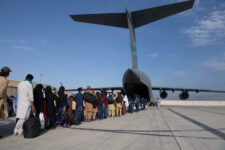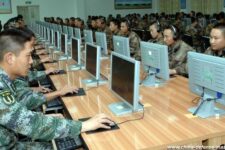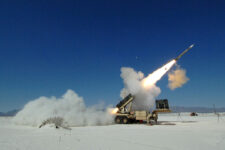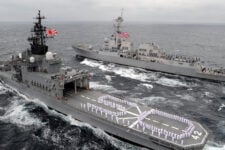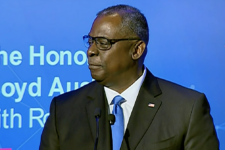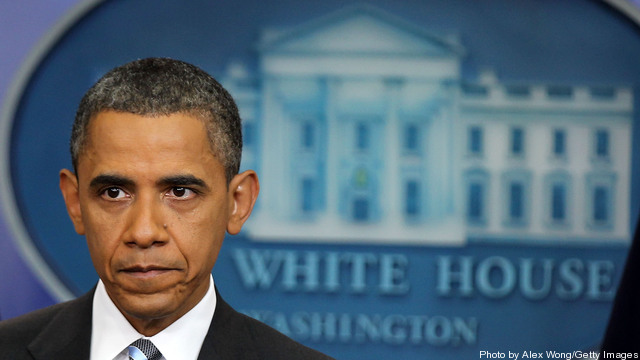Occasionally journalists find a gem, buried in the Potomac muck. They’re hard to find and often even harder to convince they should be seen by the public. Harald Malmgren spends most of his time buried deep in the darkest muck of Washington — that almost impenetrable stuff surrounding economics. But he sometimes rises forth and pens an insightful piece about national security or defense issues. While many readers will disagree with Malmgren’s conclusions about the Obama administration, his meticulous presentation and the clarity of his argument should delight none the less. Read on. The Editor.
The path to the presidency of the United States wends through a complex, volatile battlefield of competing ideologies, domestic political and financial objectives, and survival skills of incumbents and vested interests.
The weapons and tools needed to prevail include encouragement of hope for a better tomorrow, promises of change from the past, and cleverness in highlighting the flaws of an opponent.
However, once victorious in campaigning, the tools needed to manage the complex political, economic, and legal system of America are very different.
How presidential decisions are made has vast implications domestically and internationally.
The rapid pace and mind-bending variety of issues that rise to the top have been made enormously more difficult to manage in recent years. The age of full time, real time information from everywhere about almost all human activity is overwhelming.
Speeches, Threats, Executive Action Not Enough
Moreover, so much information so fast enables every member of Congress, every state and local official, and even every citizen to take a position and try to assert influence.
Presidents cannot simply rely on oratory or threats or exercise of their executive authority to overcome opposition.
These twenty-first century technologies require presidents to manage a complex decision process in which authority and responsibility are delegated to many subordinates, some close by and some remote from the White House.
That decision process requires consensus building among competing opinions and demands, because decisions can only be executed and enforced if there is broad enough support, among the Executive Branch, the Congress, and even the Courts.
The primary job of a modern day president is management, and building the confidence of politicians, citizens, and governments of other nations in how effective that management is.
Lately, the president and his White House staff have been preoccupied by major malfunctions in the rollout of “Obamacare.” The rollout of a new Department of Health and Human Services website for enrollment in the new insurance plans under “Obamacare” was disrupted by system crashes and incorrect transmittal of information from individuals to insurers. In October and November the rollout of ACA revealed Presidential promises about ability of Americans to retain their previous health insurance and doctors could not be fulfilled.
A severe drop in Congressional and public “trust” in the president and his administration seems to have developed.
There was also gradual public recognition of likelihood of much higher health care insurance costs beginning in the next year or two, at a time when family incomes after taxes were no longer rising, and indeed had been shrinking slightly in recent years. In November and December, public opinion polls showed dramatic decline of support for President Obama and for incumbent Democrats in Congress in reaction to evolving news about negative consequences of the new health care initiative.
The domestic political damage was so severe that White House aides instructed government officials to stop referring to the new health care insurance programs as “Obamacare,” and instead talk publicly about the Affordable Care Act (ACA), which is the technical name of the new national health care insurance framework.
The rapid decline in domestic political support for the president has been associated with doubts about administration credibility or “truthfulness.” Continuous ambiguities and sometimes misleading statements about other matters, including the IRS scandal, the Benghazi events, and White House assertions about Syrian toxic gas episodes accumulated in raising voter skepticism about the Obama administration’s truthfulness.
Inconsistent And Unfocused
Preoccupied by these domestic political mishaps, the administration appeared to be inconsistent and unfocused on other policy priorities, particularly in response to foreign events and pursuit of avowed foreign policy objectives.
Early in his first term of office, President Obama overruled a complex weapons technology exchange and production agreement with India that had been the result of several years of US-Indian exploration of ways to interact more actively in maintaining stability of security in the South China Sea and Indian Ocean.
Obama’s Ambassador to Delhi worked out a tentative agreement with Indian Prime Minister Manmohan Singh that would have provided access to the newest US aircraft technologies and production sharing. The White House overruled the US ambassador and the Pentagon was ordered to offer older technologies.
The Indians, having been courted for several years by the US, and delicately adjusting their own stance on relations with the US, were angered, and the lengthy efforts to enhance US-Indian security relations were abruptly discontinued. Even now, some years later, the tentative exploration of enhanced US-Indian security cooperation remains highly controversial among high-level Indian politicians.
Having put personal emphasis on the US “Asia pivot,” President Obama suggested a shift from the historic primacy of US relations with Europe, across the Atlantic, to greater focus on US interaction in the future of the Asian Pacific region.
His principal means of cementing the pivot with new relationships was to be the Trans Pacific Partnership (TPP), opening trade, financial markets, investment, and technology flow with those nations willing to join. At first Chinese leaders perceived this pivot in terms of a US policy of economic, political, and military containment of China, but the administration also emphasized a parallel effort to “normalize” and calm relations with China.
When domestic political turbulence escalated, the president canceled his planned visits to the Asian-Pacific aimed at moving the TPP forward. The Asian nations saw this cancellation as a clear sign of presidential loss of attention or interest.
China saw the shift in presidential focus as opportunity to “push the fences” between itself and its neighbors.
Successful completion of TPP would require congressional approval of a new fast-track trade negotiating authority, or TPA. However, at this turbulent moment in domestic politics, some of Obama’s key political supporters, including labor unions and labor-sensitive Congressional Democrats, are opposed to TPA.
Congressional Elections, The Base And Hesitation
White House aides seemed highly reluctant to confront Obama’s base about trade issues at a moment when the congressional elections were being put in play by domestic controversies so TPP simply faded into the background. Efforts to seek congressional action were postponed indefinitely. While it remained theoretically possible to seek passage of TPA legislation in 2014, the probability of success in Congress would decline as the 2014 congressional elections came closer. Experienced politicians in both parties saw TPA as something to deal with in 2015, at the earliest.
Other nations took note that the Asian pivot had been relegated to a “pending business” portfolio, sidelined by US domestic political priorities.
Congress took note that the president was not ready to multi-task trade issues alongside domestic efforts to quell growing unrest among Democrats and hardening of opposition to the president’s agenda among Republicans.
Vice President Biden was dispatched to attend TPP meetings and ease tensions with China, but his authority in matters of trade negotiations, trade legislation, and military positioning were questioned in Congress, as well as in a number of Asian capitals.
After asserting that use of toxic chemicals by Assad’s army would be a “red line,” the President hesitated and appeared to be vacillating about willingness to act when it was alleged that Assad had gone ahead to cross Obama’s red line. At first, the President sought authority from Congress to respond to Assad’s red line challenge with a limited military strike, suggesting that Obama was hesitant to act without public support of Congress.
Red Lines And “Weakness”
When Putin suggested an initiative to eliminate the threat of chemical warfare by gaining agreement of Syria to dispose of such weapons, Obama seized the opportunity to avoid military action, and also avoid a potential congressional division of opinion.
While the Putin initiative was a welcome political development, it was viewed by many Americans as presidential weakness and as a US concession to Putin, in effect a “loss of face” to a Russian leader much disliked by the American public.
The Gulf Cooperation Council Sunni kingdoms viewed this volte face as a clear sign of presidential weakness and vacillation. [See today’s criticism in the New York Times of the administration’s actions by a senior member of the Saudi royal family — The Editor.]
Most likely Assad viewed it as a turning point in his favor, and Putin as an opening to exploit other openings in US fences around the Middle East, Africa, and even Cuba. Putin announced publicly that Russia would enhance its military presence in the Arctic.
The US-Iran diplomatic breakthrough in recent weeks was warmly welcomed by the press and media, but generated controversy in Congress.
Moreover, it was disclosed that the administration had been conducting secret talks with Iran’s new leadership for more than a year, without consultation with political leaders in Washington or with leaders of other strategically important “friends” in the Middle East, including Israel and the Sunni kingdoms of the Gulf.
Iranian Nuclear Talks Fallout
Israel’s Prime Minister Netanyahu publicly scorned the president’s secret actions, and leaders of GCC kingdoms openly expressed anger and a sense of further betrayal by the US Administration, after Obama’s failure to act militarily in Syria.
The White House had expected political stress between the White House and Israel, but members of Congress seemed surprised and apprehensive. Perhaps more important, it subsequently became evident that the White House did not anticipate the severity of negative response from Saudi Arabia and the other GCC member kingdoms.
It has now become evident that the Sunni Arab kingdoms also felt existentially threatened by a nuclear Iran, and were now likely to seek buildup of their own military and nuclear capability as a deterrent to Iran in the future.
For example, the Saudis are already actively seeking acquisition of submarines that might be capable of sea-launched missile attack on Iran. Ironically, the US initiative to reduce tensions with Iran’s leadership seems to have set in motion a major armaments buildup in the Gulf.
(The French, well aware of the Sunni royals’ sentiments, were quick to ally themselves with the GCC, in hopes of becoming major beneficiaries of GCC purchases of military weaponry.)
Questions are now being quietly raised among members of Congress whether President Obama and Secretary of State John Kerry had gained other concessions from Iran’s leadership, particularly moderation of Iran Revolutionary Guards Corps (IRGC) activities in Iraq, Syria, Lebanon, and in support of Hamas and Hezbollah. They have vigorously argued against further congressional action to impose tougher sanctions on Iran.
However, there seems to be significant distrust in Congress about Iran’s seemingly abrupt turn from confrontation to conciliation, and distrust in the Obama/Kerry capability to manage successfully a transition to peaceful relations in US relations with Iran.
As a practical hedge against possible Iranian deception, administration aides have advised US companies to move cautiously in exploring restoration of business with Iran, and suggesting to other governments in Europe and Asia to avoid a destabilizing race to restore normal relations with Iran before further nuclear weapons assurances are negotiated with Iran’s leadership in the first half of 2015.
In the late days of 2013, China unexpectedly declared a new ADIZ (Air Defense Identification Zone) defense perimeter extending far out from the coast of mainland China and including the Senkaku/Daiyu Islands, which Japan long claimed were part of its national territory. The new ADIZ perimeter also included frequent flight paths of Japanese commercial airlines to various destinations in East Asia, and brought China’s military reach much closer to US bases in Okinawa.
The White House initially failed to organize an administration response to China’s unilateral action, and confusion ensued between US, Japan, South Korea, and other Asian nations regarding both commercial aviation parameters and military areas of engagement.
Vice President Biden was sent to “clarify” the apparent disruption to otherwise “improving” US-Chinese relationship, but Biden did not demand a rollback of the ADIZ, nor even secure an unambiguous understanding about the legitimacy and future operability of the ADIZ. [Note John Kerry did call for rollback of the ADIZ while in Vietnam today and warned the Chinese not to create any more in the region — the Editor.] Most likely unintentional, the US sensitivity to Japan’s position seemed to be overlooked. By failing to define China’s ADIZ as something not achievable unilaterally, but subject to international negotiation, the US implicitly let the existence of the ADIZ stand even if not immediately enforced by the PLA.
In these ambiguous circumstances, the South Korean government immediately followed by asserting a new ADIZ of their own, overlapping that of China and closing the security gap between the Koreas and Japan. As for Japan, Chinese warnings of brutal response if Japan challenged China’s new perimeter simply ramped up China-Japan tensions. It almost seemed that China’s PLA would welcome a limited, but deadly skirmish with Japan’s SDF.
Loss Of Confidence
As the end of 2013 approached, US foreign policy was confronted with a number of new, critical tests of US foreign and security policy positions on such varied questions as relations between the US and China, Japan, Vietnam, Indonesia, Philippines, etc. as well as on US Air Force, Navy and Marine Corps repositioning of forces in the Asian Pacific region. Together will apparent alienation of US relations with the GCC kingdoms and heightened tensions with Israel, a growing degree of foreign policy apprehension will likely also cast a public cloud of loss of confidence in the run-up to congressional elections.
These political and security strains unfolded at the time of an uncoordinated and ill-thought-through Treasury Department initiative to criticize aggressively Germany’s strong balance of payments surplus while maintaining crushing fiscal austerity pressure on most of the rest of Europe. US Treasury Secretary Lew’s public attack on Chancellor Merkel’s government — before a new coalition was fully in place — escalated Washington-Berlin political strains to the point where German diplomats privately remarked this represented the worst period in the bilateral relationship since the middle of World War II.
Returning to the issue of what constitutes an effective presidency, the Obama administration has obviously had great difficulty demonstrating continuity and determination in its relations with both friendly governments as well as unfriendly or troublesome governments. The perception abroad (even in Canada) is that the US leadership feels conflicted and threatened, overcome by the need for managing both domestic and international challenges at the same time. In Congress, there are growing signs of serious rifts not only among Republicans but also among Democrats on both domestic and foreign issues.
The White House has presented an imaginative array of explanations for its delays and inconsistencies in actions, but its “spin” seems to be losing effectiveness with Congress, with a growing number of voters and with many foreign leaders. The president’s multi-tasking management and decision system seems to be faltering. Confidence in US government leadership among other nations in continuity, clarity of direction, and willingness to execute its declared intentions seems to be fading.
Ironically, the perception of US passivity is encouraging a new arms race as other nations seek to strengthen their own security in an increasingly threatening context of weak economies, domestic political unrest, and challenges from neighbors.
Spin is a routine foreign policy tool, often sufficiently effective to maintain stability in foreign relations. Are world events now spinning out of control for this administration?
Harald Malmgren, chief executive of Malmgren Global, advises governments and companies on international trade and investment. He served as principal deputy trade negotiator for Presidents Nixon and Ford.
No service can fight on its own: JADC2 demands move from self-sufficiency to interdependency
Making all-domain operations a warfighting capability means integrating, fusing, and disseminating a sensor picture appropriate for a particular theater segment, not all of them, says the Mitchell Institute’s David Deptula.



